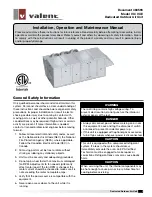
32801002001 Specifications subject to change without notice.
13
Step 6 - Refrigerant Piping
IMPORTANT:
Both refrigerant lines must be insulated separately.
• The minimum refrigerant line length between the indoor and
outdoor units is 10 ft. (3 m).
• Table 7 lists the pipe sizes for the indoor unit. Refer to the outdoor
unit’s installation instructions for the additional allowed piping
lengths and refrigerant information.
• Refer to the outdoor unit’s installation manual for details regarding
the allowable pipe length and height difference.
Table 7 — Piping Size
Use the following steps to connect the refrigerant piping:
1. Run the interconnecting piping from the outdoor unit to the indoor
unit.
2. Connect the refrigerant piping and drain line outside the indoor
unit. Complete the pipe insulation at the flare connection then
fasten the piping and wiring to the wall as required. Completely seal
the hole in the wall.
3. Cut tubing to correct length.
When preparing refrigerant pipes, take extra care to cut and
flare them properly. This ensures efficient operation and
minimizes the need for future maintenance.
a. Measure the distance between the indoor and outdoor units.
b. Using a pipe cutter, cut the pipe a little longer than the
measured distance.
c. Make sure the pipe is cut at a perfect 90° angle.
Fig. 40 — Pipe Cutting
4. Remove Burrs
Burrs can affect the air-tight seal of the refrigerant piping
connection. Therefore, they must be completely removed. To
remove:
a. Hold the pipe at a downward angle to prevent burrs from falling
into the pipe.
b. Using a reamer or deburring tool, remove all burrs from the cut
section of the pipe.
Fig. 41 — Deburring tool
5. Flare Pipe Ends
Proper flaring is essential to achieving an airtight seal.
a. After removing the burrs from the cut pipe, seal the ends with
PVC tape to prevent foreign materials from entering the pipe.
b. Sheath the pipe with insulating material.
c. Place flare nuts on both ends of the pipe. Make sure they are
facing the right direction. Once the ends are flared, it is
impossible to put them on or change their direction.
Fig. 42 — Copper pipe and flare nut
d. Remove the PVC tape from ends of pipe when ready to perform
the flaring work.
24K
36K
48K
Gas Pipe
(Connection Size)
In (mm)
5/8 (16)
5/8 (16)
5/8 (16)
Liquid Pipe
(Connection Size)
In (mm)
3/8 (9.52)
3/8 (9.52)
3/8 (9.52)
All field piping must be completed by a licensed technician and
must comply with the local and national regulations.
When the system is installed in a small room, measures must be
taken to prevent the refrigerant concentration in the room from
exceeding the safety limit in the event of refrigerant leakage. If the
refrigerant leaks and its concentration exceeds its proper limit,
hazards due to lack of oxygen may result.
When installing the refrigeration system, ensure that air, dust,
moisture or foreign substances do not enter the refrigerant circuit.
Contamination in the system may cause poor operating capacity,
high pressure in the refrigeration cycle, explosion or injury.
Ventilate the area immediately if there is refrigerant leakage
during the installation.
Leaked refrigerant gas is hazardous. Ensure there is no refrigerant
leakage after completing the installation work.
WARNING
DO NOT
install the connecting pipe until both the indoor and
outdoor units have been installed.
Insulate both the gas and liquid piping to prevent condensation.
CAUTION
Oblique Rough
Warped
90°
DO NOT DEFORM PIPE WHILE CUTTING
Be extra careful not to damage, dent, or deform the pipe while
cutting. This drastically reduces the heating efficiency of the unit.
CAUTION
Pipe
Reamer
Point down
Flare nut
Copper pipe
































